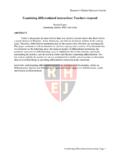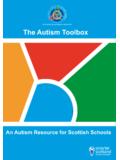Transcription of Differentiation & Grading: Can They Co-exist?
1 Copyright 2010 Carol Tomlinson1 Differentiation & grading : Can They Co-exist? Qikiqtani Teachers ConferenceIqaluit, NunavutFebruary 24, 2010 Carol TomlinsonWilliam Clay Parrish, Jr. ProfessorUniversity of is a Grade???? ..a grade (is)..an inadequate reportof an imprecise judgmentof a biased and variable judgeof the extent to whicha student has attainedan undefined level of masteryof an unknown proportionon an indefinite amountof Dressell,Michigan State UniversityCopyright 2010 Carol Tomlinson2To Untangle the grading KnotWe need to consider two elements:1) grading issues of particular concern in a differentiated classroom2)Best practices in assessment and grading3)Whether or not best practices in assessment & grading would adequately address the issues related to grading & we understand both the issues related to academically diverse classrooms and best practices in assessment & grading (and their interrelationship) we ll stay tied in a knot!
2 And unless the former leads us to solve the latter, we have a problem as 2010 Carol Tomlinson3 All learners needa balanced successto effort ratioStrugglingLearners:Heavy EffortLittle SuccessCopyright 2010 Carol Tomlinson4 AdvancedLearners:Great Success,Little EffortThe Unspoken Effect of GradesFor some students, the certainty of praise and success in school has become a drug; they continually need many other students, year upon year of not good enough has eroded their intellectual self-confidence and resulted in a kind of mind-numbing , L. (2003). Assessment as learning. Thousand Oaks, CA: Corwin, p. 2010 Carol Tomlinson5If the question is, Do rewardsmotivate students? the answer is, Absolutely! They motivate studentsto get rewards. Zen And The Art of Public School Teachingby John Perricone Publish America p.
3 68In grading , as in all other teaching decisions, we need to claim a share of the Hippocratic practices should support student certainly should not undermine it nor harm student development as 2010 Carol Tomlinson6 Essential Question: To what degree would adhering to the key principles ofeffective grading address the Differentiation -related concerns about gradingwhile eliminating error and communicating clearly to students & parents?We should seek to ensure that grades:1)Keep the Success to Effort Ratio in BalanceThat is, grades (in conjunction with schooltasks/experiences) contribute to the student s sense that when they work hard, something good generally comes of ) Ensure that students develop a growth mindsetThat is, grades (in conjunction with schooltasks/experiences) contribute to student trustthat sustained effort and hard work make most things 2010 Carol Tomlinson7We should seek to ensure that grades.
4 1)Communicate ClearlyThat is, a parent can trust that the grade is avery accurate representation of just what astudent knows, understands, and can do in agiven subject, at a given time, based on clearlyunderstood ) Support the parent in supporting learningThat is, grades guide parents in what to do next to encourage student should seek to ensure that grades are:1)RELIABLE That is, that if we were to use the same measure a couple of days, weeks, or months later, the results would be relatively the same for a given ) VALID That is, we actually measured what we meantto measure. 3) TRUE SCORE That is, the grade really represents what a student knows, understands, and can 2010 Carol Tomlinson8X = T + EThe Observed Score = the True Score + ErrorThe Grade We Give Really Indicates What the Student Knows, Understands, and Can Do + Extraneous Factors that Get in the Way of Indicating Precisely What the Student Knows, Understands and Can Grades to Be Valid, We Have to Do All We Can Do to Eliminate s the Game Plan for grading : To Ensure that OurGrades are as Close as Possible to the Student s True Score to eliminate error.
5 Let s examine six key principlesof best-practice grading to see if they would help us address concerns thatarise in regard to grading & Differentiation , balance thesuccess to effort ratio, help develop a growth mindset, communicateclearly, and eliminate 2010 Carol Tomlinson9 Principles of Effective grading & ReportingPrinciple #1 It s unwise to over-grade student workCopyright 2010 Carol Tomlinson10 Principles of Effective grading & ReportingPrinciple #2 Grades should be based on clearlyspecified learninggoalsPrinciples of Effective grading & ReportingPrinciple #3 Grades should becriterion-based,not norm-based Copyright 2010 Carol Tomlinson11 Principles of Effective grading and ReportingPrinciple # 4 Data used for gradingmust be valid (measurewhat we intend to measure).
6 That is, the data must be free of Grade Fog. CommonSources of Bias and DistortionProblems that can occur with the studentLack of reading skill/languageEmotional upsetPoor healthLack of testwisenessEvaluation anxiety Problems that can occur with the settingPhysical conditions light, heat, noise, that can occur with the assessmentitselfDirections lacking or unclearPoorly worded questions/promptsInsufficient timeMisaligned with goals and/or instructionBased on the ideas of Rick StigginsCopyright 2010 Carol Tomlinson12 Grades are broken when zeros are used:Zeros distort the actual achievement recordand can decrease student motivation to are, however, many fixes in the form of grading alternatives. Schools/districts develop policies regarding these alternatives, then indicate to their teachers which alternative(s) they can or should use in their zero has an underserved and devastating influence so much so that no matter what the student does, the grade distorts the final grade as a true indicator of mastery.
7 Mathematically and ethically this is unacceptable. Wormeli, 2006, pp. 137-138A Repair Kit for Gradingby Ken O Connor Educational Testing Service, p. 91-92 Zeros Cause Grade FogWhenever I hear statistics being quoted, I am reminded of the statistician who drowned while wading across a river with an average depth of three feet.(McMann, 2003, np)The mean can be very well named --it is truly mean to students because itoveremphasizes outlier scores, which are most often low outliners. As we seein the following case, the calculation of the mean can distort the final assessments have been converted to percentage scores to calculate a final grade:91, 91, 91, 91. 91. 91. 91. 70. 91. 91 Total; = 889. Mean = 88/9. Final grade = BThis student performed at an A level, 9 times out of 10 and the 70 is clearly ananomaly.
8 But the grade as calculated in most schools would be a Repair Kit for Gradingby Ken O Connor Educational Testing Service p. 81-82 Assigning a Mean Can Cause Grade FogCopyright 2010 Carol Tomlinson13 Principles of Effective grading and ReportingPrinciple # 5 Grade later in thelearning cyclerather than Possible SolutionsWhat About Report Cards?Copyright 2010 Carol Tomlinson14 Principles of Effective grading and ReportingPrinciple # 6 When it s time forreport cards,practice clearlydelineated content goalsHabits ofmind andworkGrowth inachievementon clearlydelineatedcontent goalsCopyright 2010 Carol an explanatory checklist with the 3 with parents during conferences aboutthe 3 Send an e-mail or a note with a report on the 3 students keep records of their 3 Ps andwrite a summary to Work to change the report any case, talk with your students consistently about the 3 Ps, their importance in student development, and their interrelationships.
9 Give 3P feedback!What Might My Grade Book Look Like?Copyright 2010 Carol Tomlinson16 Remember:the learninggoalstypically don t changewhen atask s thesupportsystem, route ofaccess, mode ofexpression,personalconnection,etc. thatgenerallyconstitutesdifferentiationC urriculum Assessment Instruction ReportingWhat is the target? (KUDs)Who s with me as we make the journey toward the KUDs?(Pre-and Formative Assessment)What do I do along the way to ensure that each student masters--&, if possible, moves beyond the KUDs?( Differentiation and best practice assessment)How do I communicate the student s status relative to the KUDs?( grading /Reporting)Copyright 2010 Carol Tomlinson17 Grade Inflation: Sense and NonsenseTeachers should set criteria for grades and determinewhat should set criteria for grades and determine what achievement level equals mastery.
10 The number of students who get A s should equal the number who master the criteria set for an A. If ourinstruction ( treatment)is effective, that number should be high!!Phi Delta Kappan Thomas F. Kelly May 2009 p. 696 Too often, educational tests, grades, and report cards are treated by teachers as autopsies when they should be viewed as physicals.(Reeves 2000, p. 10)








